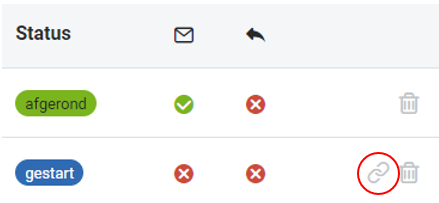Fragen & Antworten
Allgemein
Für welche Unternehmen ist das Webtool geeignet?
Wie funktioniert die Spracheinstellung?
Wie kann ich mein Probeabonnement in ein kostenpflichtiges Abonnement umwandeln?
Mein (Probe-)Abonnement ist abgelaufen. Wurden meine erstellten Fragebögen und Ergebnisse gelöscht?
Für welche Unternehmen ist das Webtool geeignet?
Was ist der Unterschied zwischen SAQ Compact und SAQ Extended?
Wo finde ich das Berechnungstool?
Befragte haben keine E-Mail-Adresse – wie gehe ich damit um?
Gesendete Einladungen landen in unserem Spam-Postfach – was kann ich tun?
How does NEN handle our data in the web tool?
Wie kann ich ein Standort hinzufügen?
Warum muss ich den Befragten "Stichworte" zuweisen?
Welche Berufsebene sollte für Hauptquartiermitarbeiter, "Verwaltung" oder "Operationen" Angestellte verwendet werden?
Wie funktioniert die Eingabe von Vor- und Nachnamen der Befragten?
Wie kann ich viele Befragte hinzufügen (oder ergänzen)? (Import)
Fragebogen
Wie erstelle und sende ich einen neuen Fragebogen?
Als Unternehmensadministrator möchte ich auch den Fragebogen ausfüllen. Wie mache ich das?
Ist das Berechnungstool für die Anzahl der Befragten obligatorisch oder kann ich davon abweichen?
Kann ich einen gelöschten Fragebogen wiederherstellen?
Erhalten die verschiedenen Job-Level (Führungskräfte/Management) auch unterschiedliche Fragen?
Erhalten die hinzugefügten Befragten automatisch eine Einladung zum Ausfüllen des Fragebogens?
Einige Mitarbeiter in meinem Unternehmen haben Schwierigkeiten beim Ausfüllen des Fragebogens. Wie kann ich die Fragen mit einer Erklärung versehen?
Wo kann ich die Bewertung pro Antwort einsehen?
Wann wähle ich den SAQ Compact oder den SAQ Extended?
Den Befragten wird mitgeteilt, dass die Frist abgelaufen ist. Wie öffne ich den Fragebogen wieder?
Befragte können nicht importiert werden – wie behebe ich das?
Do part-timers also have to complete the questionnaire?
Wie bestimme ich, für welchen Schritt ich den Fragebogen ausfülle?
Analysieren
Wie kann mein Kollege auch Fragebögen versenden oder die Ergebnisse einsehen?
Kann ich die Ergebnisse gruppieren oder filtern?
Wo finde ich die ausgefüllten Erklärungen der Befragten?
Wo kann ich die Ergebnisse herunterladen/exportieren?
Add tags (afterwards)
Bestätigen
Ich habe das Self-Assessment abgeschlossen und möchte meine Organisation zertifizieren lassen. Wie ordne ich das an?
Der Auditor kann sich nicht mehr im Webtool anmelden, wie ist das möglich?
Maßnahmenplan
What is an Action Plan?
What do I need to start an Actionplan?
SAQ
SAQ Compact: die Ergebnisse, GAP-Analyse und Aktionsplan
Wie wird die Punktzahl für den SAQ Compact berechnet?
Aus wie vielen Fragen besteht der SAQ Compact?
Aus welchen Fragen besteht der der SAQ Compact?
Was ist mit dem Begriff S&G im SAQ gemeint?
Antwortmöglichkeiten auf eine Frage (SAQ Kompakt)
Wie wird die Punktzahl für den SAQ Extended berechnet?
Aus wie vielen Fragen besteht die Fragenliste?
Aus welchen Fragen besteht der SAQ Extended?
Was ist eine Stufe?




 . Geben Sie unter Datum der letzten Antwort ein Datum in der Zukunft ein. Wenn Sie diese speichern, wird der Fragebogen wieder für die Befragten geöffnet.
. Geben Sie unter Datum der letzten Antwort ein Datum in der Zukunft ein. Wenn Sie diese speichern, wird der Fragebogen wieder für die Befragten geöffnet.